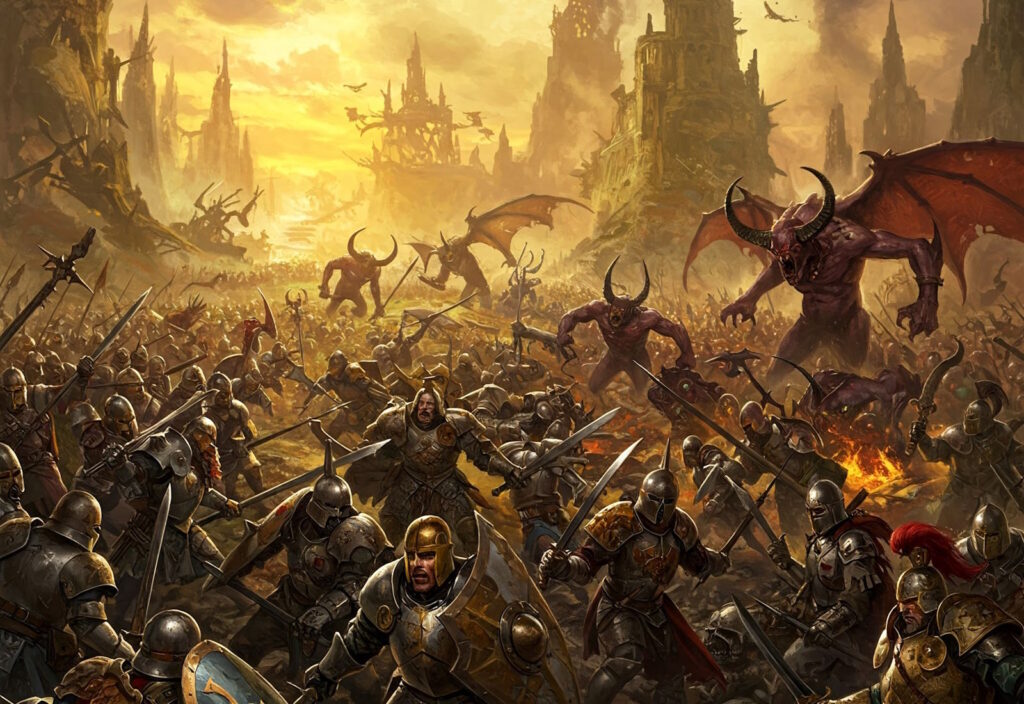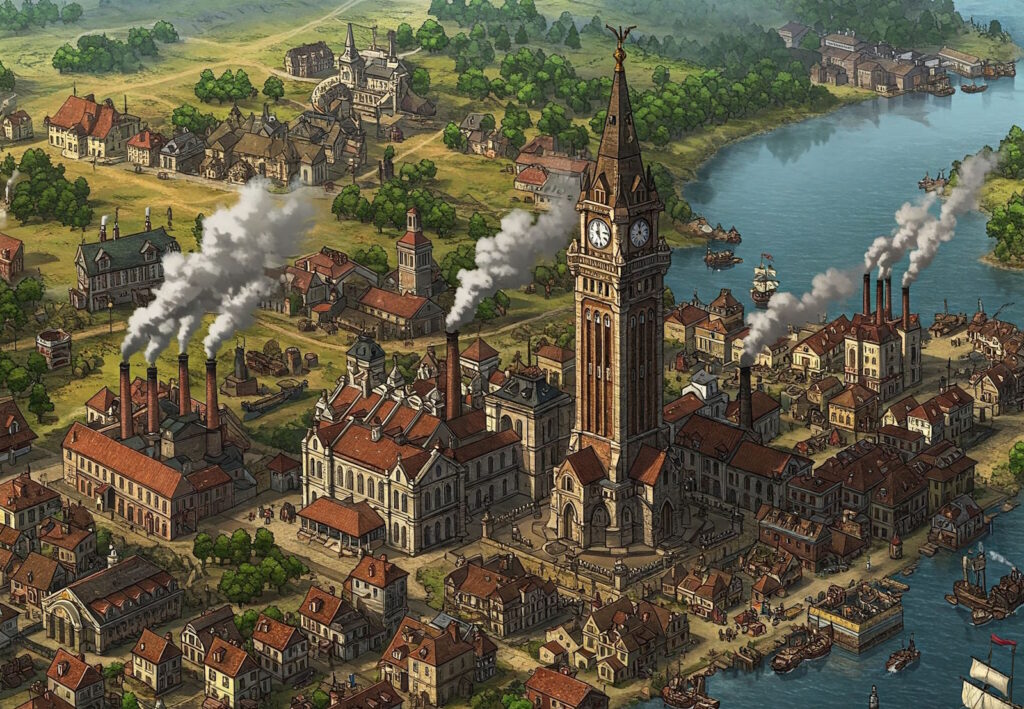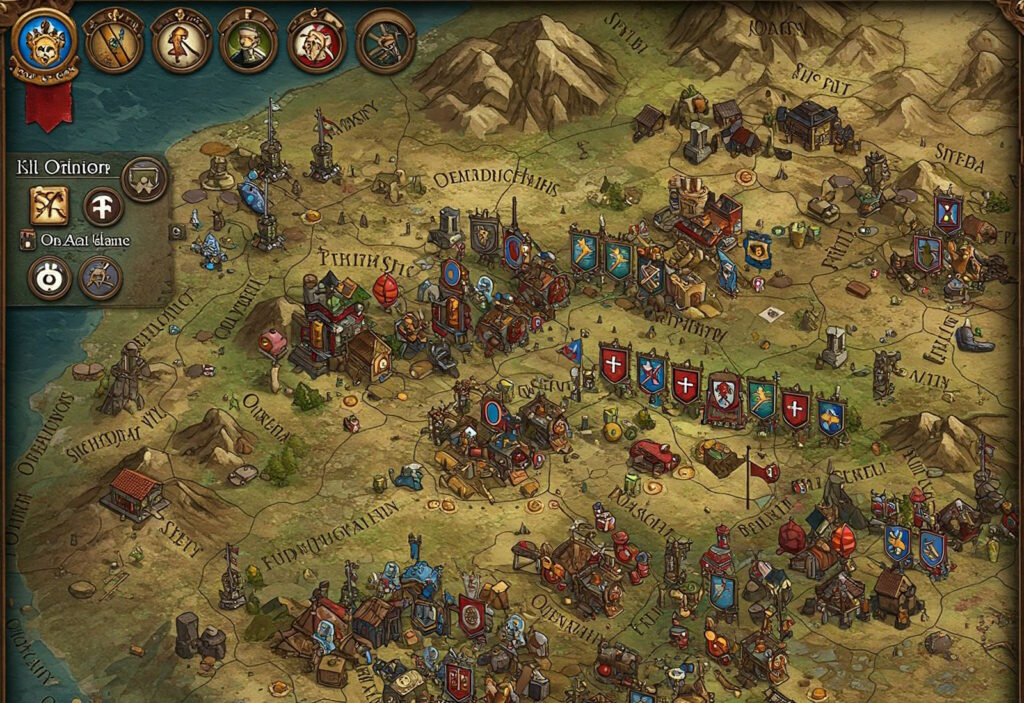Introduction to Total War: Warhammer III
Total War: Warhammer III is the third installment in the acclaimed Total War series, blending traditional real-time tactical warfare with turn-based strategy mechanics, all set within the richly developed Warhammer universe. Released in February 2022, this title stands as a testament to the prowess of Creative Assembly, the developer behind the Total War franchise. The game builds on the foundation laid by its predecessors, Total War: Warhammer and Total War: Warhammer II, while also expanding the scope of strategic gameplay and immersive lore associated with the Warhammer Fantasy world.
The development of Total War: Warhammer III has been marked by the commitment to crafting an engaging gaming experience that satisfies both longtime fans of the Total War series and ardent followers of the Warhammer lore. The game features a diverse array of playable factions, each with unique abilities, strategies, and narratives, allowing players to engage in intricate campaigns and epic battles that exemplify the depth of tactical planning and execution. This installment also introduces new gameplay mechanics such as the Realm of Chaos, amplifying the strategic possibilities and the thematic richness of the universe.
With its seamless integration of expansive world-building and intricate battle mechanics, Total War: Warhammer III plays a crucial role in the ongoing legacy of the Total War series. It not only serves as a bridge between established Warhammer lore and innovative gameplay but also caters to a broad audience. The title has been met with critical acclaim for its strategic depth, elaborate graphics, and the fidelity of its adaptation of Warhammer’s fantastical elements. This overwhelming reception underscores its significance in both the strategy game genre and the Warhammer fandom.
Gameplay Mechanics and Features
Total War: Warhammer III introduces a sophisticated blend of real-time and turn-based gameplay, enriching the player’s strategic experience. The real-time battles remain a hallmark of the Total War franchise, allowing players to command vast armies on intricately designed battlefields. Each unit fulfills distinct roles, whether they be infantry, cavalry, ranged troops, or powerful spellcasters, necessitating careful planning and tactical acumen. The chaos of battle is complemented by a user-friendly interface that enables players to issue commands effectively while maintaining control over the dynamic battlefield environment.
One of the standout features of this installment is the enhancements to turn-based strategy elements, which are critical for campaign management. Players can manage their chosen factions through an expansive campaign map, where they engage in diplomacy, expand territories, and establish economic structures. The importance of diplomatic maneuvering is underscored by the introduction of new diplomatic options, offering deeper engagement with both AI factions and other players. This fosters a complex web of alliances and rivalries, affecting both the campaign’s narrative and the overall gameplay experience.
Army management is another key aspect of Total War: Warhammer III. Players are tasked with developing their armies to suit various strategies and combat situations, employing unique mechanics such as recruitment and unit upgrades. The game incorporates the concept of attrition and unit morale, simulating the impacts of resource management and troop well-being on battle outcomes. Additionally, the introduction of unique faction abilities provides players with distinctive styles of play, further enhancing the game’s strategic depth.
New features, such as powerful legendary lords, unique faction mechanics, and enhanced campaign scenarios, add layers of complexity to the traditional gameplay. These elements not only diverge from previous installments but encourage players to experiment with different strategies, ensuring that the gameplay experience remains fresh and engaging. Through its innovative mechanics and features, Total War: Warhammer III solidifies its position as a premier strategy game in the franchise.
Factions and Units Overview
Total War: Warhammer III features a rich tapestry of factions, each with its unique lore, units, and gameplay mechanics. These factions span across the Warhammer Fantasy universe, allowing players to engage in battles that reflect their heritage and characteristics. From the ancient and noble High Elves to the monstrous and chaotic forces of the Chaos realms, each faction is designed with a distinct playstyle that caters to various strategic preferences.
One of the key factions in the game is the Daemons of Chaos, which includes various sub-factions, each representing different chaotic deities. They often excel in overwhelming their enemies with unique abilities and powerful magic, making them a formidable force on the battlefield. Conversely, the Empire, a human faction, offers a balanced approach with strong infantry and artillery options, allowing for flexibility during engagements. Their units are historically grounded, embodying the deep lore rooted in the Warhammer universe.
Another notable faction is the Vampire Coast, a collection of undead pirates who harness both gunpowder and necromancy, demonstrating an exciting blend of ranged and melee combat. Their abilities often inflict terror on opponents, showcasing the thematic elements present in Total War: Warhammer III. Additionally, the Ogres, represented by their unique playstyle of overwhelming force and mobility, deliver devastating charges that can break enemy lines quickly.
Beyond factions, the game introduces a variety of units that represent the distinctive characteristics of each faction. Players can utilize heroes, elite units, and monstrous creatures, all of which add depth to strategic planning. Understanding the strengths, weaknesses, and lore of these factions allows players to make informed decisions that align with their strategic vision throughout the campaign and multiplayer engagements, enriching the overall gameplay experience.
Graphics and Sound Design
Total War: Warhammer III presents an impressive artistic direction that enhances the overall gaming experience. The graphics are a standout feature, delivering breathtaking visual fidelity that brings the game’s diverse settings to life. Each faction’s units and environments are meticulously crafted, showcasing rich details that highlight the unique lore and characteristics of the Warhammer universe. The use of vibrant colors and dynamic lighting effects further immerse players in the fantastical realms where epic battles unfold.
The character models are also noteworthy, with intricate designs that reflect the distinct traits of each race. Whether commanding the mighty Chaos forces or the noble men of the Empire, players can appreciate the level of detail in their units. The game’s landscape, including varied terrains such as lush forests, arid deserts, and snow-covered mountains, is rendered in a way that not only looks impressive but also affects gameplay, as players must adapt their strategies to different environments.
Sound design in Total War: Warhammer III complements its stunning visuals, creating an immersive atmosphere throughout the experience. The soundtrack, composed with epic orchestral arrangements, enhances the emotional weight of battles and strategic decisions. It dynamically adjusts to the intensity of gameplay, supporting players in maintaining focus during critical moments. Additionally, the quality of voice acting adds depth to the narrative, with characters articulating their backstories and motivations, drawing players further into the lore of the Warhammer universe.
These artistic elements collectively contribute to a heightened sense of immersion. Players are not merely observers but participants in a living, breathing world where every detail serves to engage and evoke emotional responses. The combination of high-fidelity graphics and captivating sound design undoubtedly solidifies Total War: Warhammer III as a standout title in the strategy genre, making it an experience that resonates on multiple levels.
Multiplayer Experience
Total War: Warhammer III offers an engaging multiplayer experience that allows players to delve into both cooperative and competitive gameplay modes. The multiplayer environment is structured to accommodate various play styles, ensuring that players can choose how they wish to engage with others. The cooperative mode is particularly appealing as it fosters collaboration among players. Teams can join forces to tackle grand campaigns, allowing them to utilize their respective strengths in a strategic manner. This shared experience not only enhances gameplay but also builds camaraderie among participants, as they strategize and execute plans to conquer their foes.
In contrast, the competitive multiplayer aspect of Total War: Warhammer III introduces a thrilling dynamic where players can pit their strategies against one another. Players engage in multiplayer battles ranging from 1v1 skirmishes to larger scale team matches. This competitive environment requires players to adapt their tactics continuously, as they face a diverse array of opponents. The strategic depth provided by the different factions, each with unique abilities and units, ensures that every match presents a fresh challenge. Gamers often find themselves honing their skills through trial and error, learning not just from victories but also from defeats.
The community features of Total War: Warhammer III further enrich the multiplayer experience. Players can easily connect through various online platforms, enabling them to arrange matches or join larger communities dedicated to the game. Forums and discussion groups offer players a space to share strategies, tips, and insights into gameplay mechanics. These interactions contribute to a vibrant ecosystem, where knowledge and tactics are exchanged, enhancing the overall competitive spirit. Through these multiplayer features, Total War: Warhammer III creates an experience that is both immersive and engaging, solidifying its place as a premier strategy game in the genre.
Strategic Depth and Replayability
Total War: Warhammer III presents an exceptional depth of strategy, intricately designed to cater to both casual players and seasoned veterans. The game’s tactical complexity lies not only in the diverse factions available, each with unique units, abilities, and cultural traits, but also in the various campaign mechanics that demand strategic foresight. The decisions players face are multifaceted, whether selecting which faction to lead, managing resources, or engaging in diplomatic relations with other factions. Each choice influences the broader landscape of the game, creating a dense web of strategic possibilities that enhances the overall experience.
Furthermore, the variability in playstyle is significant. Players can adopt aggressive strategies, focusing on military expansion and conquest, or take a more diplomatic approach, forming alliances and negotiating treaties. This flexibility allows players to tailor their gameplay to their preferences, ensuring that no two campaigns feel the same. The game’s evolving narrative, shaped by the player’s actions and the outcomes of key battles, reinforces this variability, providing a rich tapestry for each campaign. Each faction offers its unique lore and strategic advantages, further enhancing the complexity of gameplay.
The combination of these dynamic elements leads to substantial replayability. As players navigate through different scenarios, shifting alliances, and unexpected challenges, the motivations to explore alternative strategies and factions grow. The procedurally generated elements of the game mean that every campaign can lead to a different outcome based on the variables at play, keeping the experience fresh and engaging. Whether through altering tactical decisions or experimenting with different faction strengths, players find themselves drawn back to the game repeatedly, seeking new strategies and outcomes with each campaign they undertake.
Comparative Analysis with Previous Titles
Total War: Warhammer III marks a significant evolution within both the Warhammer franchise and the Total War series, offering a plethora of enhancements that build upon the foundations laid by its predecessors. Analyzing the progression of the series, one can identify key improvements in gameplay mechanics, visuals, and user experience that differentiate it from earlier iterations.
One of the most notable advancements is the introduction of the new Realm mechanics, which offers players a diverse range of strategies and environments to explore. Unlike its predecessors, Total War: Warhammer III allows users to traverse varied realms that cater to different play styles, effectively diversifying tactical options. This complexity adds a layer of depth that was not as pronounced in Total War: Warhammer I and II. Players can now engage in more nuanced faction interactions while navigating through distinct thematic realms, which contributes to enhanced replayability.
Visually, the game showcases a remarkable upgrade in graphics and animations, creating an immersive experience that fully captures the essence of the Warhammer universe. The detailed character models and richly designed environments are a step forward from previous titles, setting a new standard in graphical fidelity for strategy games. Furthermore, the improved AI development also leads to more engaging and realistic battles, making the overarching experience feel more dynamic and alive compared to earlier iterations.
The multiplayer experience has also been refined, allowing for a seamless integration of competitive gameplay. Total War: Warhammer III expands upon the cooperative and competitive aspects seen in past titles, fostering a community that thrives on strategy and competition. Overall, the cumulative enhancements in gameplay mechanics, visual elements, and community engagement demonstrate a thoughtful evolution of the Total War: Warhammer series, solidifying its position as a premier strategy experience.
Community and Modding Scene
Total War: Warhammer III boasts a vibrant and engaged community, which significantly enhances the overall gaming experience. The fanbase is passionate and creative, continually contributing to the game through various means such as fan art, lore discussions, and content-sharing on platforms like Reddit and Steam. This active community involvement fosters a sense of belonging and shared enthusiasm, making the game much more than just a standalone product.
One of the most compelling aspects of the Total War: Warhammer III community is its modding scene. Modders have the ability to create a variety of modifications that can greatly enhance or alter gameplay, allowing players to customize their experience. The modding community has produced a myriad of mods ranging from graphical enhancements to complete gameplay overhauls. Popular mods, such as those that introduce new factions or units, can dramatically alter the strategic landscape, offering fresh strategic experiences for both new and veteran players.
The modding tools provided by Creative Assembly facilitate this creative process, enabling hobbyists and experienced developers alike to bring their ideas to life. Through platforms like the Steam Workshop, players can easily download and share these mods, thereby ensuring that the modding scene thrives. The constant influx of mods contributes to the longevity of the game, as each new mod can provide unique content and depth, keeping the player base engaged for extended periods.
Moreover, the collaboration between players, modders, and developers exemplifies a robust community spirit. Developer support for the modding scene strengthens this relationship, often leading to mod features being incorporated into official patches or expansions. This synergy not only fosters creativity but also allows the Total War: Warhammer III community to enjoy a more diverse and fulfilling gaming experience, enhancing the game’s overall appeal.
Conclusion and Final Thoughts
Total War: Warhammer III stands as a significant contribution to the strategy genre, marking a culmination of various gameplay elements that have evolved throughout the series. This installment successfully integrates grand strategy, tactical battles, and immersive lore, making it an outstanding choice for gamers who crave depth and complexity in their gameplay. With its richly detailed factions, including the unique characteristics of each race and the strategic implications of their lore, players are offered a vast array of options that enhance replayability.
The game’s mechanics are designed to cater to both veterans of the series and newcomers alike. Fresh players will find sufficient guidance through the tutorial system that introduces them to the intricacies of army management and strategic warfare, while seasoned players will appreciate the depth of strategy required to master individual factions and leverage their unique strengths. Additionally, the robust multiplayer mode allows for competitive play, appealing to those who thrive in strategic confrontations with other players.
Total War: Warhammer III not only provides a variety of gameplay options, including campaign modes and skirmishes, but it also fosters a sense of community among its participants. This makes it an excellent choice for players who enjoy engaging in discussions and strategies with peers. Thus, whether one enjoys crafting intricate battle plans or prefers to navigate the political landscapes of different factions, Total War: Warhammer III offers a comprehensive strategy experience that fulfills diverse gaming preferences.
In conclusion, Total War: Warhammer III is a quintessential example of modern strategy gaming. With its unique blend of tactical depth and expansive world-building, it undoubtedly holds the potential to enthrall a diverse audience, from amateurs to strategic veterans. Engaging with this title can provide valuable insights into effective strategy formulation, making it an essential experience for any enthusiast of the genre.



